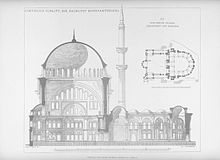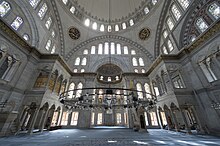User:Fnumahnoor/Nuruosmaniye Mosque

The Baroque Style of Nuruosmaniye Mosque
The Nuruosmaniye Mosque is the first Sultan Mosque in 100 years after the Sultan Ahmed Mosque[1].

Nuruosmaniye Mosque is the mosque that features the details of Ottoman Baroque style. The muqarnas is the main feature of the Baroque. The circular courtyard of the mosque is another baroque feature. The mosque is located on a second hill that once contained the mosque of Fatma Huton, the mosque was burned due to a fire. Around the Nuruosmaniye Mosque is a covered Grand Bazaar. [2]
Architectural Elements of Nuruosmaniye Mosque:
Routes: The mosque has two gates, the east and west gate. The western gate also contains the fountain and sebil. Both gates open to the Bazaar which allows a flow of traffic.[1]Topography: The Mosque is built on a second hill of Istanbul. Since the mosque is elevated from the surrounding area, the entrance is up the stairs and to the gate. The mosque contains library, madrasa, and a tomb, which are enclosed in a prescient with an irregular shape, therefore the sites slope downward in the north area.[1][2]

Lights: The windows lining the walls of the mosque allows natural light to travel through. The circular courtyard is another path the natural light flows through in. Additionally, the circular Ottoman style lamps allows light at night.[1]Ornaments: The muqarnas along the arches of the mosque are baroque and major form of decoration. The mosque is lined with golden qur’anic calligraphy and has medallion with name of Allah and Prophet Mohammad on the pendentives of the structure. The two skinny minarets decorating the outside of the mosque are an example of Ottoman structure along with the main half dome and the mini half domes of the courtyard walls. [1]Material: The mosque material is made from cut stone and marble.[3]
- ^ a b c d e Rüstem, Ünver, author. Ottoman Baroque : the architectural refashioning of eighteenth-century Istanbul. ISBN 978-0-691-18187-5. OCLC 1032673873.
{{cite book}}:|last=has generic name (help)CS1 maint: multiple names: authors list (link) - ^ a b "Nuruosmaniye Külliyesi | Exterior view from west-northwest showing courtyard before the mosque, with the Hacilar Han (left) and the Sandal Bedesten (right) seen in the foreground". Archnet. Retrieved 2019-12-02.
- ^ Goodwin, Godfrey. (2003, ©1987). A history of Ottoman architecture. Thames & Hudson. ISBN 0-500-27429-0. OCLC 52906706.
{{cite book}}: Check date values in:|date=(help)
